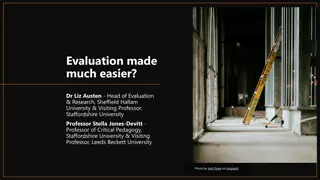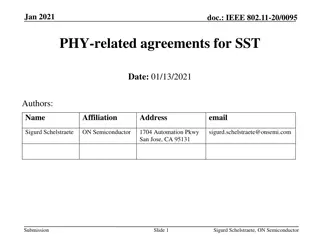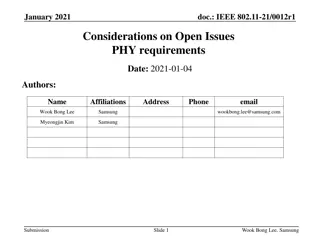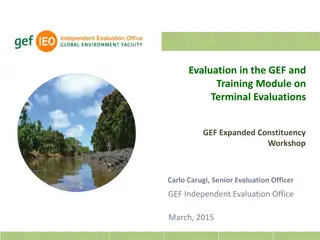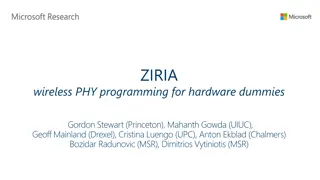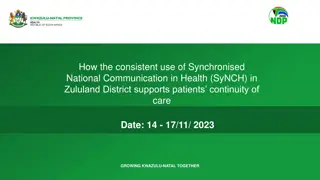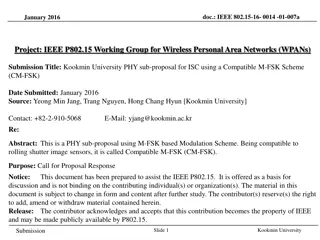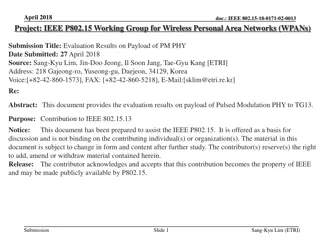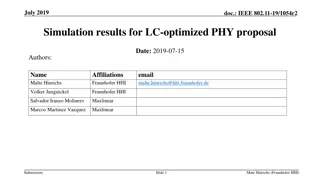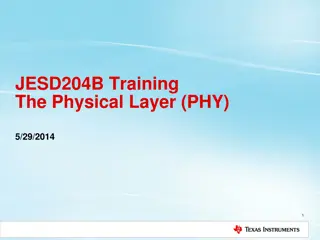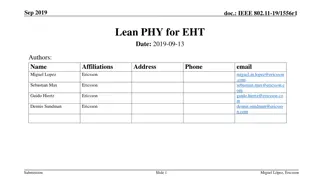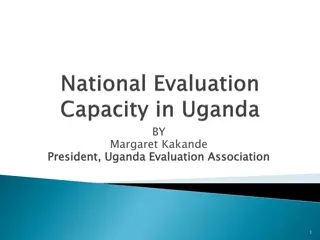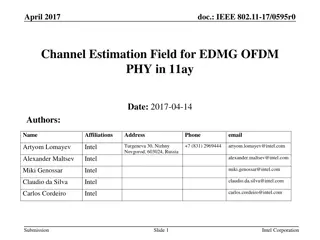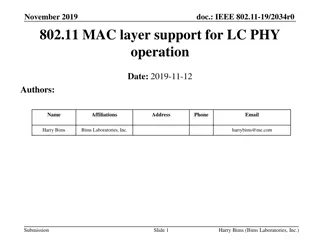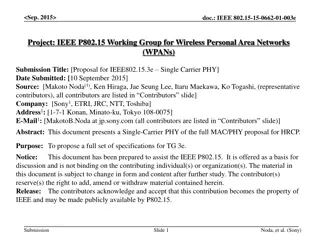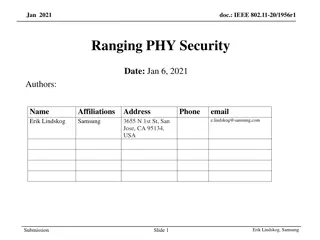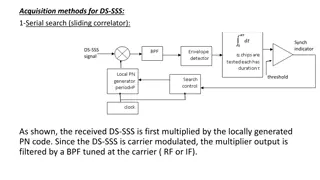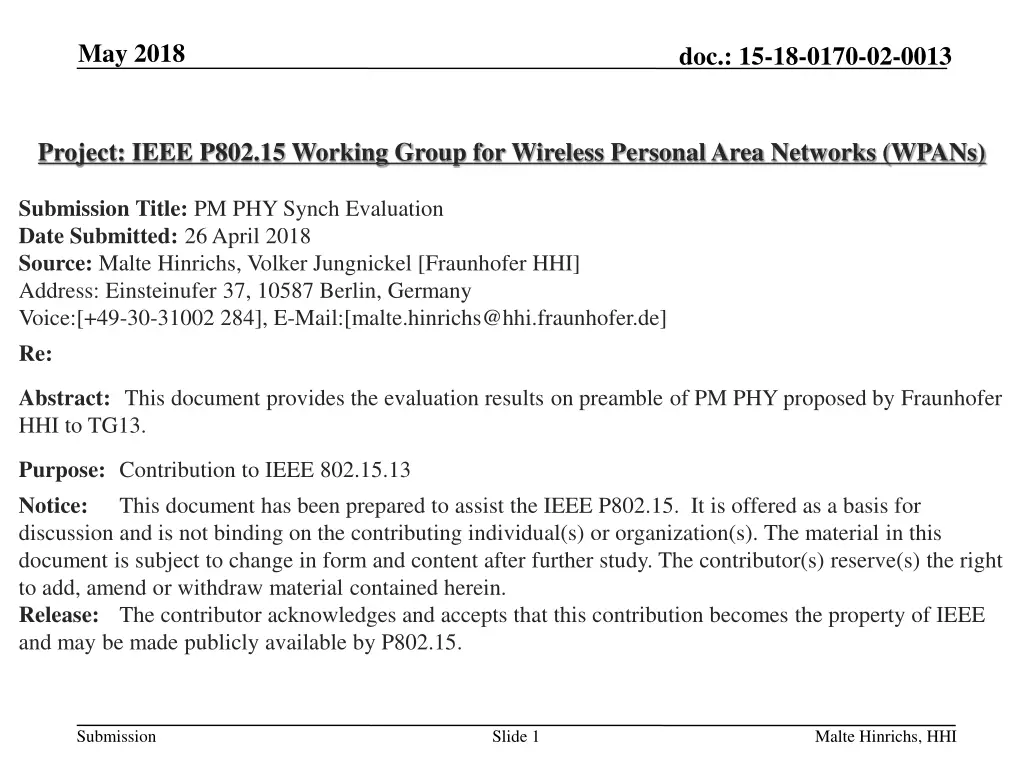
Evaluation of PM.PHY Synchronization for IEEE 802.15 Work Group
This document evaluates the synchronization performance of the PM.PHY proposed by Fraunhofer HHI for the IEEE 802.15 Working Group. It discusses the preamble structure, synchronization methods, length requirements, and frame structure for low SNR operations, such as IoT and mobile devices. The evaluation results and contributions to the TG13 are presented, highlighting the use of a Cross-correlation method with known preambles for reliable operation under challenging conditions.
Uploaded on | 0 Views
Download Presentation

Please find below an Image/Link to download the presentation.
The content on the website is provided AS IS for your information and personal use only. It may not be sold, licensed, or shared on other websites without obtaining consent from the author. If you encounter any issues during the download, it is possible that the publisher has removed the file from their server.
You are allowed to download the files provided on this website for personal or commercial use, subject to the condition that they are used lawfully. All files are the property of their respective owners.
The content on the website is provided AS IS for your information and personal use only. It may not be sold, licensed, or shared on other websites without obtaining consent from the author.
E N D
Presentation Transcript
May 2018 doc.: 15-18-0170-02-0013 Project: IEEE P802.15 Working Group for Wireless Personal Area Networks (WPANs) Submission Title: PM PHY Synch Evaluation Date Submitted: 26 April 2018 Source: Malte Hinrichs, Volker Jungnickel [Fraunhofer HHI] Address: Einsteinufer 37, 10587 Berlin, Germany Voice:[+49-30-31002 284], E-Mail:[malte.hinrichs@hhi.fraunhofer.de] Re: Abstract: This document provides the evaluation results on preamble of PM PHY proposed by Fraunhofer HHI to TG13. Purpose: Contribution to IEEE 802.15.13 Notice: This document has been prepared to assist the IEEE P802.15. It is offered as a basis for discussion and is not binding on the contributing individual(s) or organization(s). The material in this document is subject to change in form and content after further study. The contributor(s) reserve(s) the right to add, amend or withdraw material contained herein. Release: The contributor acknowledges and accepts that this contribution becomes the property of IEEE and may be made publicly available by P802.15. Submission Slide 1 Malte Hinrichs, HHI
May 2018 doc.: 15-18-0170-02-0013 IEEE P802.15.13 Evaluation of PM PHY synchronization Date: 2018-04-26 Place: Warsaw, Poland Authors: Name Company Address Phone Email Malte Hinrichs Fraunhofer HHI Fraunhofer HHI malte.hinrichs@hhi.fraunhofer.de Volker Jungnickel volker.jungnickel@hhi.fraunhofer.de Submission Slide 2 Malte Hinrichs, HHI
May 2018 doc.: 15-18-0170-02-0013 PM PHY Scope Low SNR operation E.g. IoT, uplink for mobile devices Hadamard- or 8B10B coded PAM, Reed-Solomon FEC Sync Robust synchronization/frame start detection required Reliable operation even if SNR is too low for data transmission Proposed method: Cross-correlation with known preamble What length is needed for the preamble? Submission Slide 3 Malte Hinrichs, HHI
May 2018 doc.: 15-18-0170-02-0013 Preamble structure Sequence Enhanced Gold sequence AN: (N-1)-bit Gold sequence appended with a 1-bit for balancing Sequence lengths for AN : N = 16, 32, 64 Repetition pattern: + + + Optimized for use of Minn auto-correlator Good autocorrelation properties (low side peaks) Resulting preamble: [AN AN AN AN AN AN] Overall length is 6*N Submission Slide 4 Malte Hinrichs, HHI
May 2018 doc.: 15-18-0170-02-0013 Simplified frame structure Bit scaling Bipolar mapping around DC bias: 0/1 -1/+1 Modulation signal power = 1 Simulated frame: Zeros (L = 6*N bits) Preamble (L bits) Random data (L bits) Emulates the beginning of the PHY frame Random bits Zeros Preamble 96/192/384 bits each Submission Slide 5 Malte Hinrichs, HHI
May 2018 doc.: 15-18-0170-02-0013 Channel simulation Apply Channel Impulse Response (CIR) Upsampling, convolution with CIR, downsampling Add AWGN Test 10,000 noise realizations Detector: Cross correlation with ideal preamble Selection of first value > threshold per frame Count positive detection rate n n Detector Zeros Preamble X + Random bits AWGN CIR Submission Slide 6 Malte Hinrichs, HHI
May 2018 doc.: 15-18-0170-02-0013 Detection threshold Finding of threshold Generate frame with 100,000 noise samples SNR (relative to preamble power): -5 dB Perform cross-correlation of the preamble at all possible shifts 100,000 random correlation values Random values are sorted (see CDF) Detection threshold is selected so that 0.1% of all random values lie above it 0.1% false positive rate Submission Slide 7 Malte Hinrichs, HHI
May 2018 doc.: 15-18-0170-02-0013 Detection threshold False Alarm Rate: 0.1% Submission Slide 8 Malte Hinrichs, HHI
May 2018 doc.: 15-18-0170-02-0013 Evaluation Synchronization reliability according to IEEE 802.15.13 evaluation framework AWGN channel Scenario 3, Device 3 (S3/D3): clean CIR, little spreading Scenario 4, Device 7 (S4/D7): dirty CIR, energy is spread over several peaks, frequency selective Optical Clock Rates 3.125..200 MS/s Requirement: Detection rate 99.9% at false positive rate 0.1% Submission Slide 9 Malte Hinrichs, HHI
May 2018 doc.: 15-18-0170-02-0013 CIR Scenario 3, D3 Submission Slide 10 Malte Hinrichs, HHI
May 2018 doc.: 15-18-0170-02-0013 CIR Scenario 4, D7 Submission Slide 11 Malte Hinrichs, HHI
May 2018 doc.: 15-18-0170-02-0013 AWGN: Detection ratio for different preamble lengths Submission Slide 12 Malte Hinrichs, HHI
May 2018 doc.: 15-18-0170-02-0013 S3/D3: Detection ratio for different preamble lengths @3.125 MS/s Submission Slide 13 Malte Hinrichs, HHI
May 2018 doc.: 15-18-0170-02-0013 S3/D3: Detection ratio for different preamble lengths @6.25 MS/s Submission Slide 14 Malte Hinrichs, HHI
May 2018 doc.: 15-18-0170-02-0013 S3/D3: Detection ratio for different preamble lengths @12.5 MS/s Submission Slide 15 Malte Hinrichs, HHI
May 2018 doc.: 15-18-0170-02-0013 S3/D3: Detection ratio for different preamble lengths @25 MS/s Submission Slide 16 Malte Hinrichs, HHI
May 2018 doc.: 15-18-0170-02-0013 S3/D3: Detection ratio for different preamble lengths @50 MS/s Submission Slide 17 Malte Hinrichs, HHI
May 2018 doc.: 15-18-0170-02-0013 S3/D3: Detection ratio for different preamble lengths @100 MS/s Submission Slide 18 Malte Hinrichs, HHI
May 2018 doc.: 15-18-0170-02-0013 S3/D3: Detection ratio for different preamble lengths @200 MS/s Submission Slide 19 Malte Hinrichs, HHI
May 2018 doc.: 15-18-0170-02-0013 S4/D7: Detection ratio for different preamble lengths @3.125 MS/s Submission Slide 20 Malte Hinrichs, HHI
May 2018 doc.: 15-18-0170-02-0013 S4/D7: Detection ratio for different preamble lengths @6.25 MS/s Submission Slide 21 Malte Hinrichs, HHI
May 2018 doc.: 15-18-0170-02-0013 S4/D7: Detection ratio for different preamble lengths @12.5 MS/s Submission Slide 22 Malte Hinrichs, HHI
May 2018 doc.: 15-18-0170-02-0013 S4/D7: Detection ratio for different preamble lengths @25 MS/s Submission Slide 23 Malte Hinrichs, HHI
May 2018 doc.: 15-18-0170-02-0013 S4/D7: Detection ratio for different preamble lengths @50 MS/s Submission Slide 24 Malte Hinrichs, HHI
May 2018 doc.: 15-18-0170-02-0013 S4/D7: Detection ratio for different preamble lengths @100 MS/s Submission Slide 25 Malte Hinrichs, HHI
May 2018 doc.: 15-18-0170-02-0013 S4/D7: Detection ratio for different preamble lengths @200 MS/s Submission Slide 26 Malte Hinrichs, HHI
May 2018 doc.: 15-18-0170-02-0013 AWGN: required SNR vs. preamble length Submission Slide 27 Malte Hinrichs, HHI
May 2018 doc.: 15-18-0170-02-0013 S3/D3: required SNR vs. preamble length @3.125 MS/s Submission Slide 28 Malte Hinrichs, HHI
May 2018 doc.: 15-18-0170-02-0013 S3/D3: required SNR vs. preamble length @6.25 MS/s Submission Slide 29 Malte Hinrichs, HHI
May 2018 doc.: 15-18-0170-02-0013 S3/D3: required SNR vs. preamble length @12.5 MS/s Submission Slide 30 Malte Hinrichs, HHI
May 2018 doc.: 15-18-0170-02-0013 S3/D3: required SNR vs. preamble length @25 MS/s Submission Slide 31 Malte Hinrichs, HHI
May 2018 doc.: 15-18-0170-02-0013 S3/D3: required SNR vs. preamble length @50 MS/s Submission Slide 32 Malte Hinrichs, HHI
May 2018 doc.: 15-18-0170-02-0013 S3/D3: required SNR vs. preamble length @100 MS/s Submission Slide 33 Malte Hinrichs, HHI
May 2018 doc.: 15-18-0170-02-0013 S3/D3: required SNR vs. preamble length @200 MS/s Submission Slide 34 Malte Hinrichs, HHI
May 2018 doc.: 15-18-0170-02-0013 S4/D7: required SNR vs. preamble length @3.125 MS/s Submission Slide 35 Malte Hinrichs, HHI
May 2018 doc.: 15-18-0170-02-0013 S4/D7: required SNR vs. preamble length @6.25 MS/s Submission Slide 36 Malte Hinrichs, HHI
May 2018 doc.: 15-18-0170-02-0013 S4/D7: required SNR vs. preamble length @12.5 MS/s Submission Slide 37 Malte Hinrichs, HHI
May 2018 doc.: 15-18-0170-02-0013 S4/D7: required SNR vs. preamble length @25 MS/s Submission Slide 38 Malte Hinrichs, HHI
May 2018 doc.: 15-18-0170-02-0013 S4/D7: required SNR vs. preamble length @50 MS/s Submission Slide 39 Malte Hinrichs, HHI
May 2018 doc.: 15-18-0170-02-0013 S4/D7: required SNR vs. preamble length @100 MS/s Submission Slide 40 Malte Hinrichs, HHI
May 2018 doc.: 15-18-0170-02-0013 S4/D7: required SNR vs. preamble length @200 MS/s Submission Slide 41 Malte Hinrichs, HHI
May 2018 doc.: 15-18-0170-02-0013 PM PHY: BER vs. SNR PAM-2, bipolar Submission Slide 42 Malte Hinrichs, HHI
May 2018 doc.: 15-18-0170-02-0013 Summary Performance of preamble detection has been evaluated Using AWGN and CIRs in Scenarios 3D3 and 4D7 Detection threshold was selected for 0.1% false positive rate Results indicate minor impact of channel: Similar performance for AWGN and Scenario 3D3 up to an OCR of 200 MS/s and for Scenario 4D7 up to 25 MS/s ~ 2dB degradation in Scenario 4D7 at 50 MS/s, no detection for 100 MS/s and 200 MS/s Submission Slide 43 Malte Hinrichs, HHI

